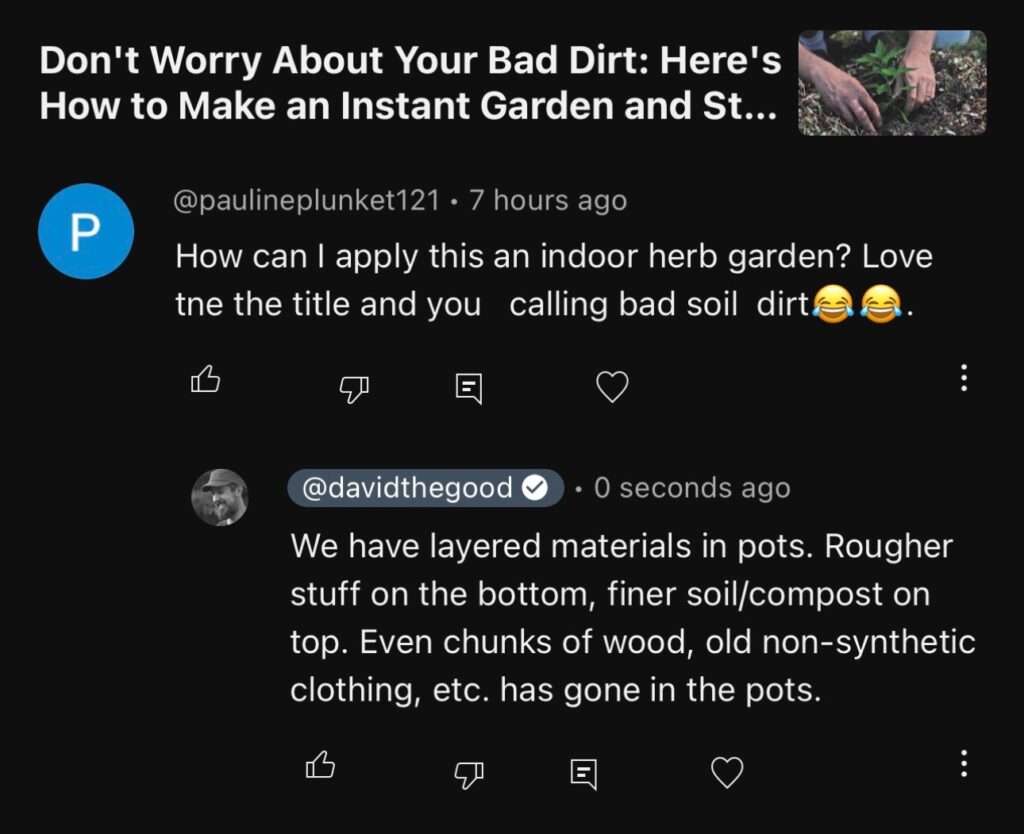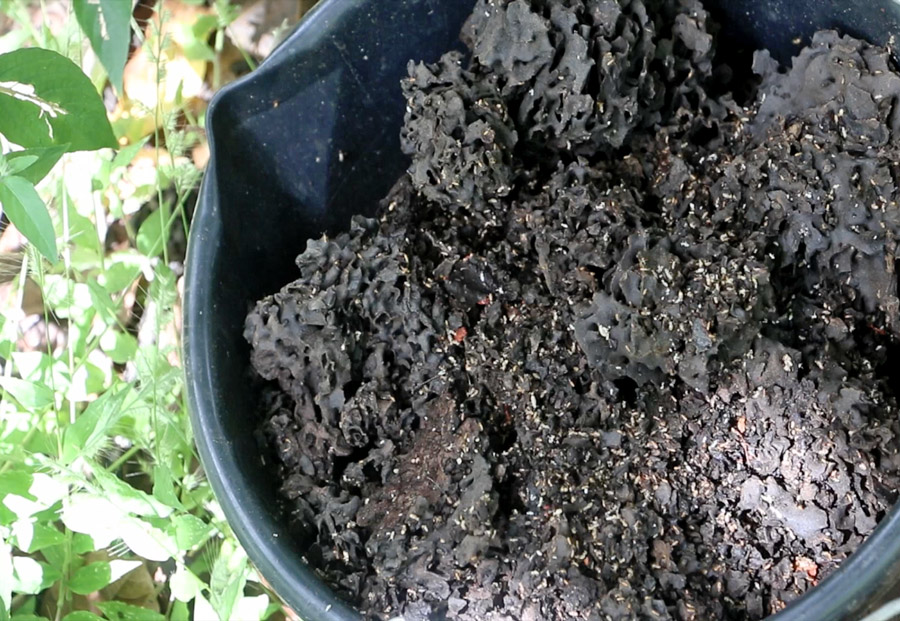A recent comment highlights one of my favorite themes:

That’s from this video:
Though gardening indoors isn’t my favorite, and neither is gardening in pots, we have had good success using non-conventional “potting mixes” when we’ve been forced to container garden.
As I stated in my reply, chunks of wood and sticks and non-synthetic clothing can be placed in the bottom of containers or even in raised beds to fill in space. Old clothing – and eventually rotting wood – will act as a reservoir for moisture.
There are quite a few unmatched socks in the bottom of the half-barrels where I potted my dwarf coconut palms. There are also chunks of rotten magnolia wood along with sticks and leaves.
If you’re buying potting soil, it gets quite expensive to fill larger containers. On a smaller scale, we often stuff fall leaves in the bottom of pots first, filling them about 1/3 full, then covering that with potting mix. Though you would think this might “rob nitrogen,” it doesn’t seem to be a problem.
If a plant starts to look a bit yellow, we foliar feed it by misting the leaves with a fertilizer solution, whether that be a commercially produced dilute liquid fertilizer, or compost tea, or Dave’s Fetid Swamp Water.
My current potting mix for the nursery consists of rotten pine shreds from a sawmill, decomposed peanut waste from a shelling facility, pine bark with a little soil mixed in, dried cow manure, compost if we have it, and a generous sprinkling of pulverized limestone. We’re always trying to figure out how we can source materials locally and avoid having to buy mixes. Besides, buying peat moss from Canada and perlite from who-knows-where and having them shipped to Lower Alabama just does make sense to me.
Other alternate materials we’ve added include biochar, leaf mold, grit from a steam bed, worm castings, rotten hardwood bark, rabbit manure, ashes, coffee grounds, crushed termite nests, and rotten wood from old trees found in the forest.
You can get quite creative when you learn to COMPOST EVERYTHING!
Think a little differently and a world of possibilities opens up.
And by “a little differently,” I mean cheap and local.


4 comments
You tuber Food forest Namibia gave you a shout out in his latest video about black water harvesting. He said that you left a comment one of his videos and that he was a fan of yours. I think his situation is similar to yours when you were in Grenada and also couldn’t be more different.
Thank you! I will go look it up. He has a tough situation – very little rain!
My compost “pile” is in a 55 gallon nursery container. It sits behind the house on the edge of the driveway which means I have more garden space in the yard.
It’s more like pit composting, I dig little holes and dump food scraps in. They disappear in 1-2 days. If I dig to the bottom I find worms. Every year there is a healthy population of black soldier flies & larvae.
It is very efficient and I believe it stays warmer and possibly gets better aeration than a regular pile would (I also drilled small holes in the sides and bottom of the container). I don’t ‘turn’ it, other than digging the holes.
When it gets too full I fill a 5 gallon bucket, picking out anything that looks unfinished, and spread it in the garden.
I’ve been using this method for about 5 years now, it works very well for a sub-urban setting.
This is what I do in containers.
However, the squirrels and dogs like to dig in them. To keep the squirrels out, I use tulle netting. It’s relatively cheap and can be found in the sewing department of stores.
For persistent dogs I sprinkle red pepper. Most times I put kitchen scraps in a covered container with holes in it and a lid. I water in the scrap container so the nutrients can get into the bigger container. I put sticks, leaves, veggie scraps, cotton t shirts, cardboard and paper, toilet paper rolls, anything else I think will break down in the pot. I fill mine up with those things then I add a thin layer of soil on top. By the time seedlings sprout and grow roots, the other stuff will break down.
Also, if it’s just for you, the pots don’t have to be filled all the way up. Only put in what the particular plants root system needs. I have five gallon buckets with only the top half filled and my cherry tomatoes are loving it. The bottom half is milk jugs, water bottles and coffee containers for water reservoirs.
Comments are closed.